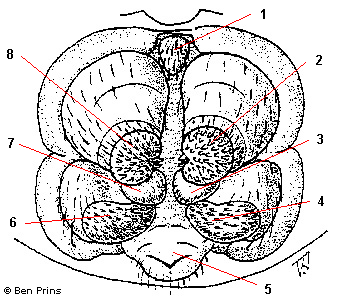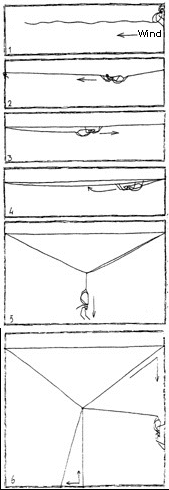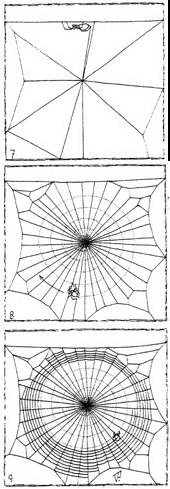| The spinnerets of a
typical spider viewed from the rear. Drawing by Ben
Prins. Annotation by Bill Amos. 1. Colulus, a vestigial spinneret, probably
without function. |
 |
The Spiders Web
Part II
by Bill Amos, Vermont, US
Drawings by Ben Prins, Holland
As remarkable as animal architecture can be—soaring "magnetic" termite mounds in Australia, the hexagonal perfection of a honeycomb cell, house-sized communal nests of African weaver birds—there is nothing so elegant, so versatile and perfectly suited to its function as a spider's web.
In our own best-kept houses there will be a bit of webbing in corners, the attic, the basement. Early any morning there is the glint of webbing on the lawn and in the lilacs. Walk through the forest, and strands fall across your face and cling to your clothes. Watch a spider drop down from a single thread in quiet air, then turn and scramble back up, gathering and consuming the protein-rich silk as it goes.
| The spinnerets of a
typical spider viewed from the rear. Drawing by Ben
Prins. Annotation by Bill Amos. 1. Colulus, a vestigial spinneret, probably
without function. |
 |
Peering back through the mists of time, we wonder: what were the first webs like? From fossilized anatomical details, we realize that the earliest spiders produced silk, but know nothing of its pattern. Web design today is limited only by the number of different kinds of spiders in the world, over thirty thousand species, each a distinct architect in its own right.
Although web patterns suggest the evolution of arachnid lifestyles, inanimate webs themselves cannot evolve. As clues, however, webs are important in understanding how behavioral complexity increased through time. We might guess that the first single strands were little more than lifelines constructed from threads of excretory secretions. The advantage might simply be one of safety: if a dragline is in place, a spider blown from a branch can always return to its perch.
A highly sophisticated group of modern spiders, the salticids, or jumping spiders, use draglines extensively. Their attentive, catlike behavior and excellent eyesight endears them to biologists. I'm a zoologist and ecologist, not an arachnologist, but I confess to having spent many, many hours closely watching and photographing jumping spiders all over the world. When a salticid leaps into space, it can scramble back where it came from if the landing spot is unsatisfactory or it misses an intended victim.
A possible next step: from a simple dragline origin, silk might have been helpful to line cavities in which spiders waited for passing prey. This could have resulted from dragline after dragline being attached from top to bottom of a burrow, until there were so many they formed a protective lining that kept loose soil from tumbling in. I've watched pale geolycosid hunting spiders on Atlantic dunes build such burrows deep in the sand. When you brush away the surrounding sand, the burrow remains intact. Trapdoor spiders from the American Southwest not only use a webbed mesh to keep their earthen burrows from collapsing, they build a hinged covering lid out of webbing that holds camouflaging dirt and plant fragments.
Suppose draglines remain outside a burrow following a spider's attack upon a passing victim? After a while the threads might serve as trip lines to alert the lurking spider whenever a strand is disturbed. (This trick is also used by a number of marine worms living shallow seas.) For considering spiders, it's no stretch of the imagination to pass from accumulated trip lines to jumbled masses of threads commonly found in old houses (and poorly imitated by Hollywood special effects artists).
Later in spider history more organized sheets of webbing appeared, especially like those of common funnel web spiders. Here one lip of a webbed tube extends out in front of a silken burrow to serve as an apron of non-sticky threads. Some believe this light-colored blanket advertises a "safe" landing place for flying insects; that when their clawed legs become tangled in the webbing, it vibrates with their struggles and the spider rushes out from its funnel-lair. Nothing safe about such a landing pad.
It has also been argued that the first webbing might have been used to accept and hold sperm produced by courting males, then used to encase developing eggs. It makes little difference whatever idea is correct, for all of these methods are in practice today. For example, under her raised abdomen, a female lycosid carries a little ball of webbing containing eggs. When the eggs hatch, she tears open the webbed ball with her fangs, allowing the babies to tumble out. They then crawl upon her back. She carries them until they molt, after which they descend to hunt on their own.
A unique underwater web is found among completely aquatic spiders native to Europe and Asia. A female diving spider repeatedly carries air to a diving bell made of water-repellent webbing attached to underwater plants. Not only is the glistening silvery air-filled dome her dining room, it is a secure submarine habitat into which she lays her eggs, whereupon it becomes the hatchlings' nursery.
Sheet webs are essentially two-dimensional, but on a misty morning we see hundreds of hammock-like webs suspended in evergreen trees. The important feature is not so much the flat sheet, but vertical threads that rise like a scaffold to overhanging parts of the plant. Because these strands are almost invisible, they serve much as cables did when suspended from barrage balloons during the Battle of Britain in World War II. A flying insect comes zipping along and crashes into one of the threads. The momentarily confused victim falls to the sheet below and is quickly caught by the alert spider.
Sticky scaffold webs lacking sheets are common among a particular group of small spiders, but when I studied one of their kind native to Pacific island rain forests, I found it relied more upon stealth and leaf vibration than upon web-building. Other kinds of spiders use silk in ways that almost defy belief.
Dinopid spiders make square nets held widespread between their legs. When an insect flies by, the net is cast to enmesh the victim and is then gathered back in precisely the same way I've seen Polynesian fishermen use nets to snare reef fishes. Another spider makes a replica of a South American bolas with a sticky blob at the end of a long thread. The weighted strand is twirled and thrown directly at a flying insect. If such methods aren't sufficiently awesome, there are spiders that have dispensed with silk entirely and instead spit a zigzag band of glue so quickly a victim is immobilized in the blink of an eye.

 But the beautiful familiar
orb web is the greatest work of art and the most sophisticated of
all (see drawings left and right). This marvel of
construction is simple in concept: it is a diaphragm, a drumhead,
secured around its perimeter, with the spot of greatest vibration
in the center—which is usually where the spider builder
resides. When an insect hits outer portions of the diaphanous
disk, vibrations travel down the non-sticky radial threads to the
center and the spider instantly knows in which direction to head.
The victim is held firm until she arrives, for the
circumferential threads have globs of stickiness. Some species of
orb builders don't stay on the web itself, but attach a
"telegraph" line to the sheet of webbing, then sit in a
nearby bush holding the line taut. The web diaphragm vibrates,
the message is transmitted, the spider descends and dashes out on
the correct radius to secure its dinner.
But the beautiful familiar
orb web is the greatest work of art and the most sophisticated of
all (see drawings left and right). This marvel of
construction is simple in concept: it is a diaphragm, a drumhead,
secured around its perimeter, with the spot of greatest vibration
in the center—which is usually where the spider builder
resides. When an insect hits outer portions of the diaphanous
disk, vibrations travel down the non-sticky radial threads to the
center and the spider instantly knows in which direction to head.
The victim is held firm until she arrives, for the
circumferential threads have globs of stickiness. Some species of
orb builders don't stay on the web itself, but attach a
"telegraph" line to the sheet of webbing, then sit in a
nearby bush holding the line taut. The web diaphragm vibrates,
the message is transmitted, the spider descends and dashes out on
the correct radius to secure its dinner.
The simplest sort of webbing is perhaps the most important. Ballooning allows many kinds of spiders to disperse around the world, wafted on air currents across even the widest oceans and highest mountains. When conditions of breeze and season are right, young spiders ascend to the top of any available elevation, spin a few short strands of silk, feel the tug of the wind, and let go. They arrived on Krakatau in 1883 within weeks after that volcanic island exploded and destroyed all life. Charles Darwin gathered them in mid-Atlantic during his trip on H.M.S. Beagle, and ballooning spiderlings have been collected from airplanes at very high altitude. I watched minute airborne spiders arrive on mid-Pacific islands from the nearest continent over two thousand miles away. I remember an astonishing spring day in the Eastern United States when from horizon to horizon the cloudless blue sky sparkled with pinpricks of light. It was so eerie, so beautiful, my skin rose in goose bumps—until it prickled with hundreds of tiny spiderlings alighting on me to seek their way in the world.
Comments to the author Bill Amos welcomed.
© William H. Amos 1998
Editor's notes: Bill Amos' earlier Micscape articles on spiders are -
There are good animations of a spider making a web in the multimedia encyclopaedias 'Encarta' and 'World Book' under the topic 'spiders'.
The author and Editor thank Ben Prins and Jan Parmentier for supplying and help with the images.
Published in December 1998 Micscape Magazine.
Please report any Web problems
or offer general comments to the Micscape Editor,
via the contact on current Micscape Index.
Micscape is the on-line monthly
magazine of the Microscopy UK web
site at Microscopy-UK